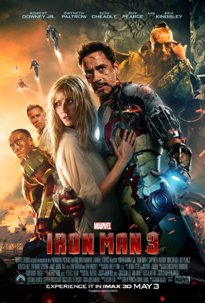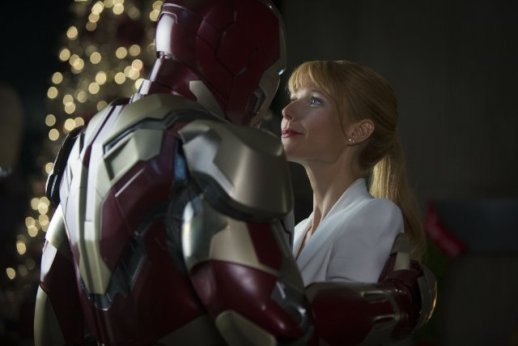Examining Iron Man 3 and its Place in the Marvel Cinematic Universe

The potential “end” is for Robert Downey Jr. as the character of Tony Stark in standalone Iron Man movies. In recent interviews, the forty-eight-year-old actor has seemed relatively gung ho about continuing the role in another Avengers film, but decidedly less so about appearing in Iron Man 4 or 5.
Conversely, the beginnings represented by Iron Man 3 are of the 2013 summer movie season, and of Phase 2 of the so-called Marvel Cinematic Universe (MCU). The idea being that the initial set of Marvel superhero movies (beginning with Iron Man in 2008 and ending with Captain America: The First Avenger in 2011), were part of a series leading to the release of The Avengers in 2012. That was Phase 1. Phase 2 begins with Iron Man 3 and will include Thor: The Dark World, Captain America: Winter Soldier, and Guardians of the Galaxy before concluding with The Avengers 2 in 2015. All of this makes Iron Man 3 a fairly significant movie. After all, The Avengers was the third-highest grossing film worldwide of all time. And a big part of its success was the positive buzz created by the other Phase 1 flicks. Some of them were more successful than others, but they all made a lot of money and most were critically well received.
[springboard type=”video” id=”684143″ player=”cnim002″ width=”560″ height=”315″ ]
Clearly though, Tony Stark is the centerpiece of the MCU. The first Iron Man started the current golden era of Marvel superhero movies, and Robert Downey Jr. has been critically acclaimed in his role as the egotistical, wealthy scientist Stark. That’s why Iron Man 3 gets the coveted position of “leadoff hitter” for Phase 2. Obviously, Marvel and Disney are expecting a huge windfall from The Avengers 2 in 2015, and the success of Iron Man 3 should set the tone for the remainder of the Phase 2 films. The financial success of the potential final Iron Man film (at least in its current form) is all but guaranteed, but the degree of that success is in question. How the film performs domestically will probably rest largely on its buzz and word-of-mouth. The question is whether it will start Phase 2 off with a hit, or a home run. If the opening weekend box office is any indication, it would appear as though the film may just be a grand slam.

Black has also been quoted as saying that Iron Man 3 is like a “Tom Clancy-style thriller,” and that certainly isn’t an entirely inaccurate description. Tony does (seemingly) battle terrorists in the movie, and spends most of his screen time out of the suit and sleuthing around, using his wits to survive. Those scenes are actually quite good, and it is certainly an intriguing approach for the filmmakers to take. But in the end, it just feels like something is missing. The stakes were so high in The Avengers that, by comparison, Iron Man 3 simply feels like a bit of a letdown. Without a doubt, this is something every one of the Marvel movies will have to deal with going forward. After seeing all of the Marvel heroes in one place and kicking ass together as a team, it begs the question of why we would ever want to see a movie featuring just one of them. Unfortunately, Iron Man 3 fails to provide a compelling answer to that question.
[springboard type=”video” id=”719723″ player=”cnim002″ width=”560″ height=”315″ ]
That isn’t to mention that, for a movie responsible in part for setting the table for The Avengers 2, Iron Man 3 seems to have an almost pathological aversion to acknowledging the phenomenon of the first Avengers movie. Yes, the events are referred to a number of times, but never in great detail, and each time Tony is asked “what happened in New York” his response is usually something akin to “I don’t want to talk about it.” Of course, the question could be asked of whether Iron Man 3 should even be judged for its merits as a table-setter for The Avengers 2. But I personally tend to think that Marvel set itself up for this type of criticism with their big Phase 2 announcement. Like it or not, every Marvel film from here on out will be judged on two fronts: how good it is as an individual film, and how good it is as a prequel serving The Avengers 2. For Iron Man 3, those answers turn out to be “pretty good” and “not very good at all.”
In Iron Man 3, none of the other Avengers are mentioned by name, and there are no cameos from any of them. Similarly, S.H.I.E.L.D. and Nick Fury don’t even make an appearance (marking the first time Fury hasn’t shown up in an Iron Man movie). Obviously, part of the intent with Iron Man 3 was to make a more personal film, focusing on Tony and his relationship with Pepper Potts (Gwyneth Paltrow) in particular. And the film itself succeeds on that front. But there is only so much disbelief that can be suspended in this world that Marvel has created. During the events of Iron Man 3, the United States faces a grave danger that leaves a large number of people dead. Are we really to believe that the government wouldn’t call in S.H.I.E.L.D. or the Avengers to help deal with that threat? Thor has somewhat of a built-in excuse for his absence given his otherworldly whereabouts, but why wouldn’t Captain America, the ultimate patriot, respond to a series of terrorist attacks on U.S. soil?

A scene from “Iron Man 3.” Photo by Zade Rosenthal
© 2012 MVLFFLLC. TM &2012 Marvel. All Rights Reserved.
A cameo from any of the other Avengers would have made sense in Iron Man 3, and would have served the additional purpose of building anticipation for upcoming Marvel projects (including, obviously, The Avengers 2). And if no Avengers are going to show up, the movie should at least provide a convincing reason as to why not. Certainly, there are a number of plot holes and inconsistencies to be found in Iron Man 3, but the question of “why don’t they just call the Avengers” is among the most frustrating, and one that all of the Marvel movies (with the possible exception of Thor, for the aforementioned reasons) from here on will have to deal with. I only hope that the filmmakers can do a more convincing job of addressing that issue in forthcoming Phase 2 movies. Ultimately, Iron Man 3 is good entertainment, and a potential worthy conclusion to the Iron Man saga. But it is also a potentially bad omen for the buildup initiative to The Avengers 2. Like it or not Marvel, the Avengers have been assembled, and future Phase 2 efforts would be wise not to ignore that fact.


